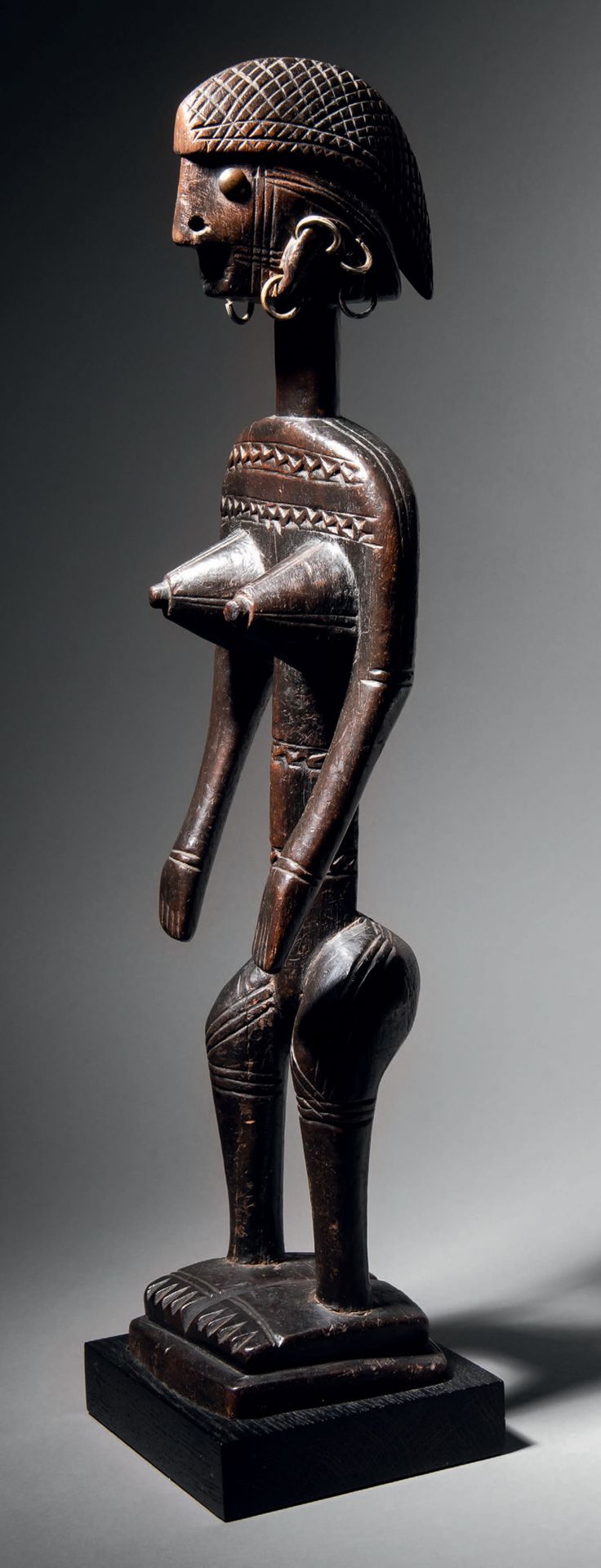Description
Ɵ So-called Jonyeleni beautiful female figure, Société du Jo, Bamana, Mali Presumed time: late 19th century Wood with brown patina, milking nails and metal rings H. 47 cm So-called Jonyeleni beautiful female figure, Jo society, Bamana, Mali H. 18 ½ in Provenance: - Quay-Lombrail sale, Paris, 30 June 1994, lot 10 - Gaston de Havenon collection, New York - Private collection The Bamana live in Mali southwest of the Dogon territory. Like the Dogon, their society is patrilineal and patrilocal. Essentially farmers, producing millet, sorghum and fonio, they have a strong ancestor cult and initiation societies organized by age group. These societies are of great importance to the Bamana. They teach the understanding of everything related to nature, the human being and the destiny that God has in store for him. The Bamana initiation society is called Jo (or Dyo) - jo jo meaning "the truth" - and also designates institutions such as the Ntomo, the Kono or the Tyiwara which function as regulatory and protective bodies for the community as well as intermediaries between the temporal and spiritual worlds. Originally, the Jo is feminine. It was the women who found its material representation in the bush and gave it to the men who organised the society according to the principles of this original Jo. This is why among the corpus of objects linked to the Jo cults, the Jonyeleni female statues like this one are essential. It is a materialization of the soul of the feminine entity at the origin of the creation of the initiatory practices that govern the society and maintain the social order. Our example, which comes from this corpus, has all the characteristics of Bamana art. A relatively schematic plastic, like the Dogon neighbours, but unlike the latter whose aesthetic could be described as austere, the Bamana sculptor generously deploys the articulation of volumes. Sometimes frank and clear like the junction between the very flat bust and the gushing breasts, sometimes more supple and continuous like the curves of the legs and the soft line that runs from the shoulders to the hands. The presence of the geometric decoration representing the scarifications associated with a very beautiful patina of age testifies to the importance of this work whose primary purpose was to enhance the presence and social function of the Jo during the septennial ritual representations in which this beautiful Jonyeleni statuette was used. Note that two other examples seem to be from the same workshop, one is kept at the MET in New York (ref. 1979.206.12), the other in a private collection (collected in situ around 1925 by R. Chaimbaux), published in Lumière Noire. Arts Traditionnels by the Tanlay art center in 1997 (n°18). Ɵ This lot is in temporary importation
27
Ɵ So-called Jonyeleni beautiful female figure, Société du Jo, Bamana, Mali Presumed time: late 19th century Wood with brown patina, milking nails and metal rings H. 47 cm So-called Jonyeleni beautiful female figure, Jo society, Bamana, Mali H. 18 ½ in Provenance: - Quay-Lombrail sale, Paris, 30 June 1994, lot 10 - Gaston de Havenon collection, New York - Private collection The Bamana live in Mali southwest of the Dogon territory. Like the Dogon, their society is patrilineal and patrilocal. Essentially farmers, producing millet, sorghum and fonio, they have a strong ancestor cult and initiation societies organized by age group. These societies are of great importance to the Bamana. They teach the understanding of everything related to nature, the human being and the destiny that God has in store for him. The Bamana initiation society is called Jo (or Dyo) - jo jo meaning "the truth" - and also designates institutions such as the Ntomo, the Kono or the Tyiwara which function as regulatory and protective bodies for the community as well as intermediaries between the temporal and spiritual worlds. Originally, the Jo is feminine. It was the women who found its material representation in the bush and gave it to the men who organised the society according to the principles of this original Jo. This is why among the corpus of objects linked to the Jo cults, the Jonyeleni female statues like this one are essential. It is a materialization of the soul of the feminine entity at the origin of the creation of the initiatory practices that govern the society and maintain the social order. Our example, which comes from this corpus, has all the characteristics of Bamana art. A relatively schematic plastic, like the Dogon neighbours, but unlike the latter whose aesthetic could be described as austere, the Bamana sculptor generously deploys the articulation of volumes. Sometimes frank and clear like the junction between the very flat bust and the gushing breasts, sometimes more supple and continuous like the curves of the legs and the soft line that runs from the shoulders to the hands. The presence of the geometric decoration representing the scarifications associated with a very beautiful patina of age testifies to the importance of this work whose primary purpose was to enhance the presence and social function of the Jo during the septennial ritual representations in which this beautiful Jonyeleni statuette was used. Note that two other examples seem to be from the same workshop, one is kept at the MET in New York (ref. 1979.206.12), the other in a private collection (collected in situ around 1925 by R. Chaimbaux), published in Lumière Noire. Arts Traditionnels by the Tanlay art center in 1997 (n°18). Ɵ This lot is in temporary importation
You may also like
